Ottawa is Canada’s capital and it is located in Ontario on the border between English-speaking and French-speaking Canada. Thus, on the opposite bank of the Ottawa River is the town of Gatineau, which is part of the metropolitan area surrounding the capital.
In Ottawa there are many sights, and of course the Canadian government buildings are among the best known. The main building on Parliament Hill is the so-called Center Block, which stands in neo-Gothic architecture, that is clearly seen inside, for example, in the Confederation Hall and in the Hall of Honor.
A visit to Ottawa also offers prestigious national museums where you can get acquainted with art, culture and history. You should also go walking in the Marché By / ByWard Market neighborhood, which is equal to relaxation, activities, shopping and gastronomic experiences.
There are many recreational opportunities in Ottawa and in the surrounding area. You can, for example, go boating on the Canal Rideau and the Ottawa River, and enjoy walks in the city parks like at Dow’s Lake. The excursion possibilities out of town are many as well and can, for example, go to the large city of Montréal.
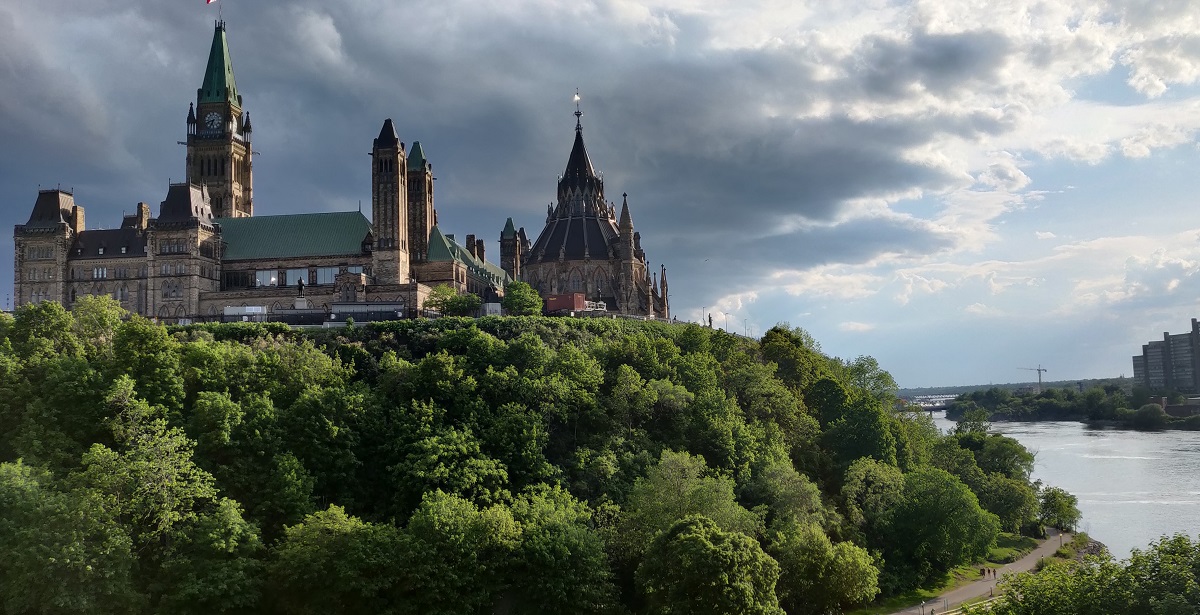
Parliament Buildings is the name for the Canadian parliament buildings located on Parliament Hill in Ottawa. The large area with its many castle-like Neo-Gothic buildings was military until Queen Victoria chose Ottawa as the Canadian capital, whereby a new government complex was to be built.
Barrack Hill, today called Parliament Hill, was chosen as the seat of government because of its good location above the city and the river. It also made it easier that the Crown already owned the piece of land. In 1859, a competition was launched for the design of the government complex, and 298 proposals were received.
A proposal by Thomas Fuller and Chilion Jones in Victorian High Gothic was chosen for the central part of the facility, while Thomas Stent and Augustus Laver’s design was chosen for the design of the buildings to the east and west of the central structure. The sophisticated use of Gothic architecture was intended to contrast with the neoclassicism of the US capital.
Construction began in 1859 and the later King Edward VII laid the foundation stone for the central block. The great facilities were not yet finished when three British colonies, which are today the provinces of Ontario, Québec, Nova Scotia and New Brunswick, formed the Canadian federation. Ottawa remained the capital and construction continued.
The Parliament Buildings on Parliament Hill were completed in 1876 and the complex immediately became an Ottawa landmark. The buildings stood until 1916, when the central block burned, so it had to be rebuilt. The original foundation stone was relaid, and as a new central element, the 92-metre-high Peace Tower was erected as a memorial to fallen Canadians during the First World War.
Today you can take a nice walk in the area and the green surroundings along the Ottawa River. The central part of the complex lies to the northeast, where the Center Block with the Peace Tower in the middle and the side buildings East Bock and West Block on either side of the axis through the Center Block. At the back of the building is the Library of Parliament.
From here you can walk south-west along Wellington Street, where many of the area’s other government buildings are located. The best known of these are the Confederation Building from 1928-1932 and the Justice Building, which was built 1935-1938. After these you can see the Canadian Supreme Court building.
You can enjoy the many beautiful buildings from the outside, and you can also visit several of the buildings on Parliament Hill. That way you can experience Canadian democracy. Most of the buildings can be seen on guided tours, while there is also an exhibition where you can explore for yourself.
Rideau Hall is the official residence of the Canadian monarch and of the Governor General of Canada, who is the monarch’s representative in the country. It is a status that Rideau Hall shares with the Citadelle de Québec in the city of Québec. However, this has not always been the purpose of the large palace.
The building was thus built in 1838 as a residence for Scotsman Thomas McKay, and he named the house after the large construction of the Rideau Canal. After Queen Victoria’s choice of Ottawa as the Canadian capital, the place was set up as the monarch’s residence on visits to the city, and the formal name became Government House.
When Bytown was chosen as the capital of Canada, a design competition was launched in 1859 for a new parliamentary complex. The project included a newly built mansion for the Governor-General, but for financial reasons the mansion was not built, and that was the reason why Rideau Hall was chosen.
Thomas McKay’s mansion was modest in size, and the year after the lease was entered into in 1864, the house was extended, which happened repeatedly to ensure a suitable setting both as a residence and as a representative place for, not least, the Governors-General’s many formal affairs.
You can visit Rideau Hall on organized tours, where you can experience the many beautiful halls that make up the mansion’s State Rooms. It is here that the Governor General performs official duties, welcomes dignitaries and honors Canadians. The mansion is home to a fine collection of Canadian art and furniture, which you also see along the way.
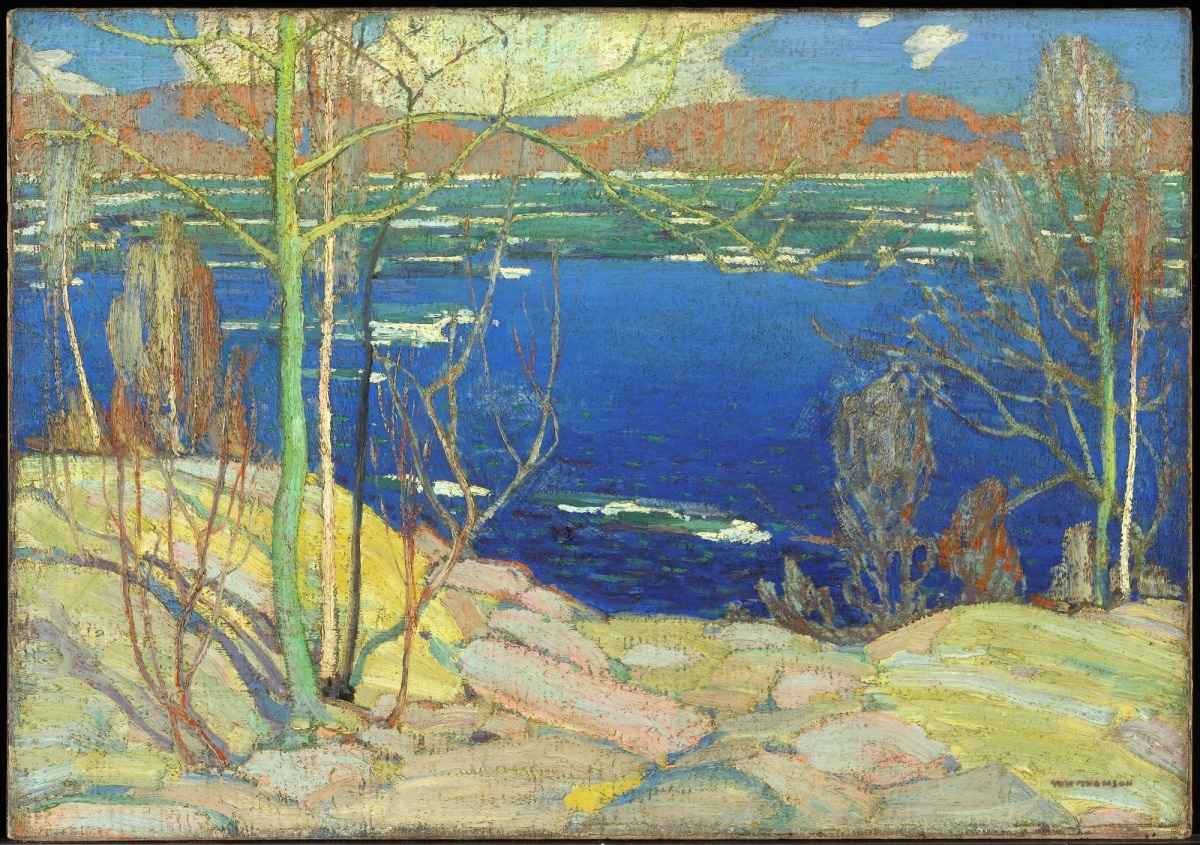
The National Gallery of Canada is one of the leading art museums in Canada. It was established by the Canadian Governor General in 1880 in connection with the founding of the Royal Canadian Academy of Arts. The museum was then located at various addresses, such as in the Victoria Memorial Museum building, until the current museum building was built for the purpose and opened in 1988.
The museum was built in glass and granite to a design by Moshe Safdie, and the building has an exciting modern architecture that was inspired by history to, among other things, look like a cathedral, where concrete pylons were used in the same way as buttresses on Gothic cathedrals. At the main entrance, the large design is emphasized with the transition of the facade to a glass dome.
The National Gallery of Canada’s permanent collection contains countless works representing numerous artistic movements and eras in art history. The gallery has a large and varied collection of not least paintings, sculptures, drawings and photographs. The museum’s collection consists mainly of works by Canadian artists, who are the focus of the institution.
The bulk of the Canadian collection includes works from the 18th century French possessions to the present day. The collection is varied and includes paintings from before the formation of Canada, abstract art and other post-war art and much more. Canada’s indigenous population is of course also represented in the collections and exhibitions.
The Canadian Museum of History is Canada’s fine national museum of human history with a natural focus on Canadian culture and history. Here there are many exciting depictions and interesting effects in the exhibitions, and you can see, among other things, the First Peoples Hall about Canada’s original population, and the Canadian History Hall about the country’s history.
While Ottawa is located in the province of Ontario, the Canadian Museum of History is located in the city of Gatineau in the province of Quebec on the opposite bank of the Ottawa River from the capital. Here is the architecturally exciting museum building that was designed by Douglas Cardinal and where the Canadian Museum of History has been located since 1989.
The history of the museum dates back to 1856, when the Geological Survey of Canada founded a museum that expanded with an anthropological collection in 1910. It later became the National Museum of Canada, which was later divided into several museums. The Canadian Museum of History took on its current name and focus in 2013.
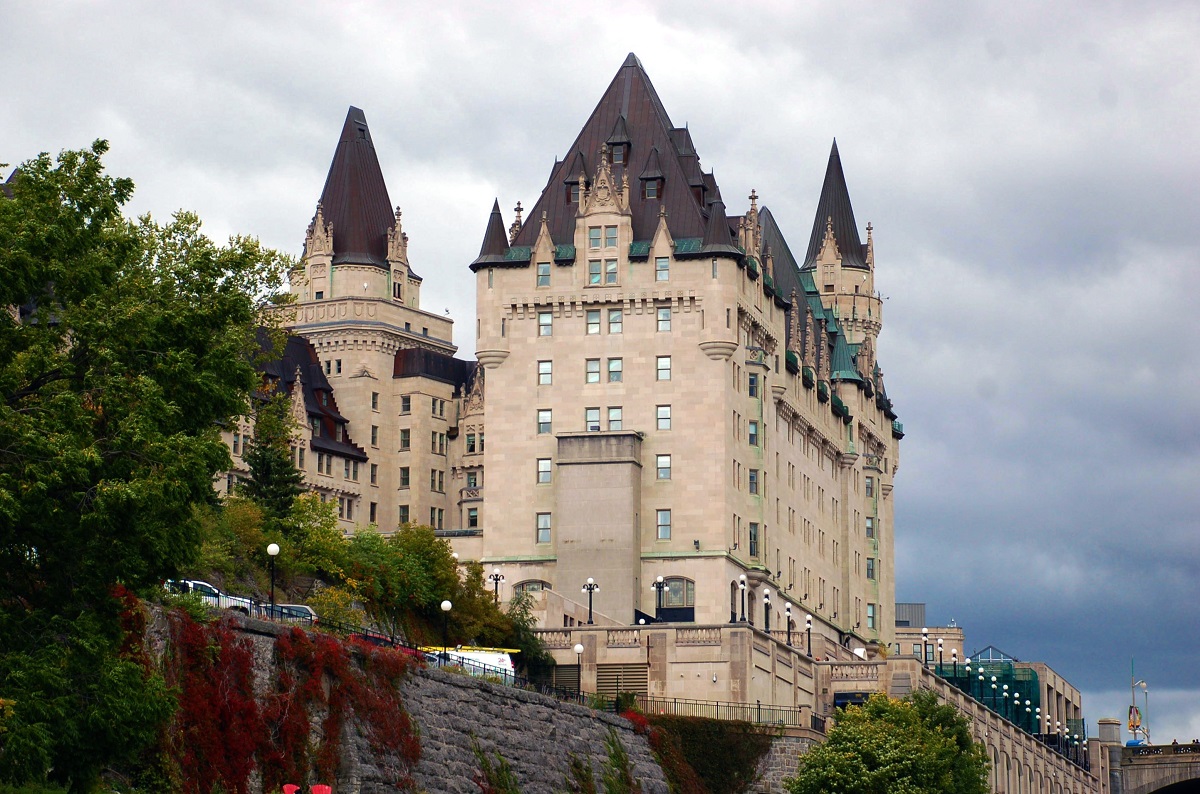
Château Laurier is a large and well-located hotel that was built in the French neo-Gothic château style as one of Canada’s many beautiful railway hotels. They were magnificent ones that were opened along the railways across Canada to offer travelers a luxurious setting during their train journeys in the great country.
Château Laurier opened across from Ottawa’s Parliament Buildings in 1912 and was connected to the then Union Station through a tunnel. Like other railway hotels of the time, the Château Laurier was also beautifully situated in the countryside along the Ottawa River and at Major’s Hill Park.
It was the Grand Trunk Railway that built the hotel from 1909 to 1912. It was named after Canadian Prime Minister Sir Wilfrid Laurier, who had helped secure the location for the new hotel. Château Laurier is still fitted out as a luxury hotel, and it stands today as one of Ottawa’s best-known buildings.
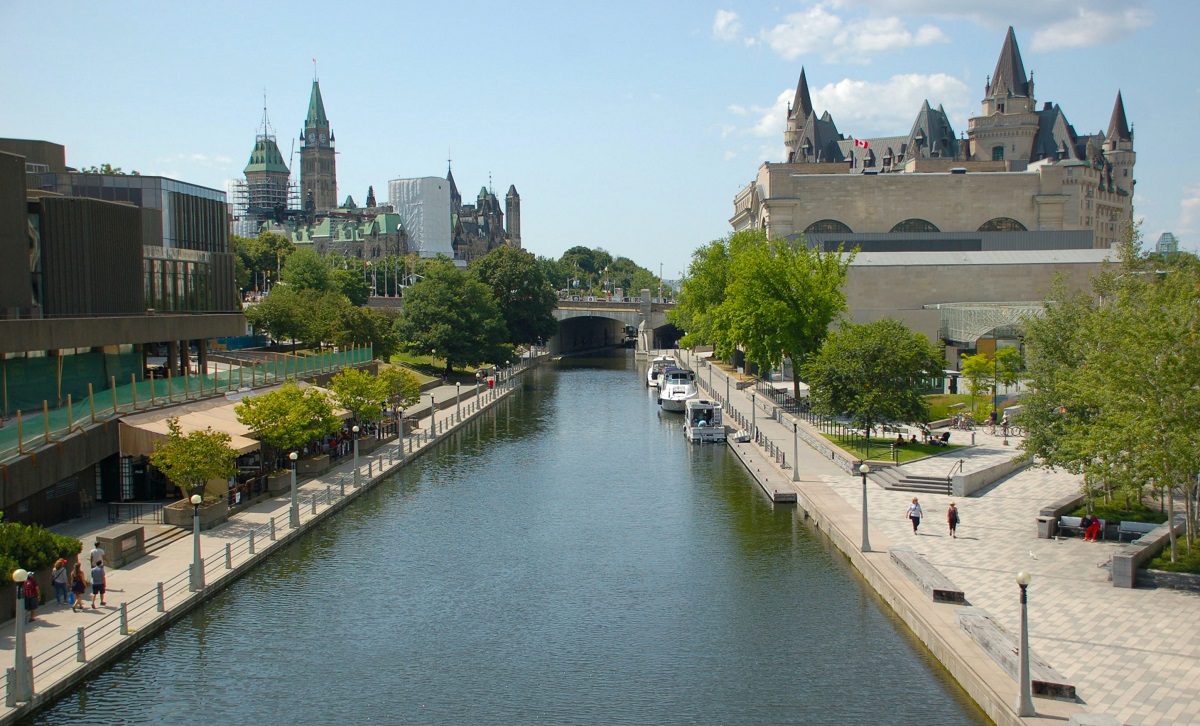
The Rideau Canal is a 202 kilometer canal that connects Ottawa by water with Lake Ontario and the St Lawrence River. The canal can be seen through central Ottawa, and its lock system is the oldest in North America in continued use. The name Rideau Canal comes from the Rideau Falls, located where the Rideau River flows into the Ottawa River.
The canal opened in 1832 and its 46 locks lift ships from the Ottawa River 83 meters upstream on the Rideau River to the Rideau Lakes, and from there there is a 50 meter drop downstream on the Cataraqui River to Kingston and Lake Ontario. Over time, transport was moved to St. Lawrence Seaway, roads and railways, but the canal is used today not least by yachtsmen.
In 2007, the Rideau Canal was inscribed as a UNESCO World Heritage Site as the best-preserved example of this type of canal in North America constructed on a large scale following European models. You can get a good impression of the canal and its locks from Wellington Street.
ByWard Market is a shopping and entertainment district in Ottawa that is popular with locals and tourists. In the market area, there are both market halls and lively activity in the market streets of George Street, York Street and William Street as well as in Byward Market Square.
The story started when Lieutenant Colonel John By of the Royal Engineers was sent from England in 1826 to oversee the construction of the Rideau Canal. As part of the work, the town was planned and the first market building was erected in 1827 on George Street. Today’s market hall between George Street and York Street dates from 1926.
Ottawa City Hall is the Canadian capital’s city hall, consisting of a combination of a 19th-century wing and modern additions. The old part is particularly interesting, having been erected as the Ottawa Normal School in 1874.
The modern part of the town hall, which is the main building, was designed by the Canadian architect Raymond Moriyama and built in 1990. The town hall’s council chamber is located in this part. The current buildings are not the city’s first town halls. That was the status of the first town hall, which was used from 1849 to 1877.
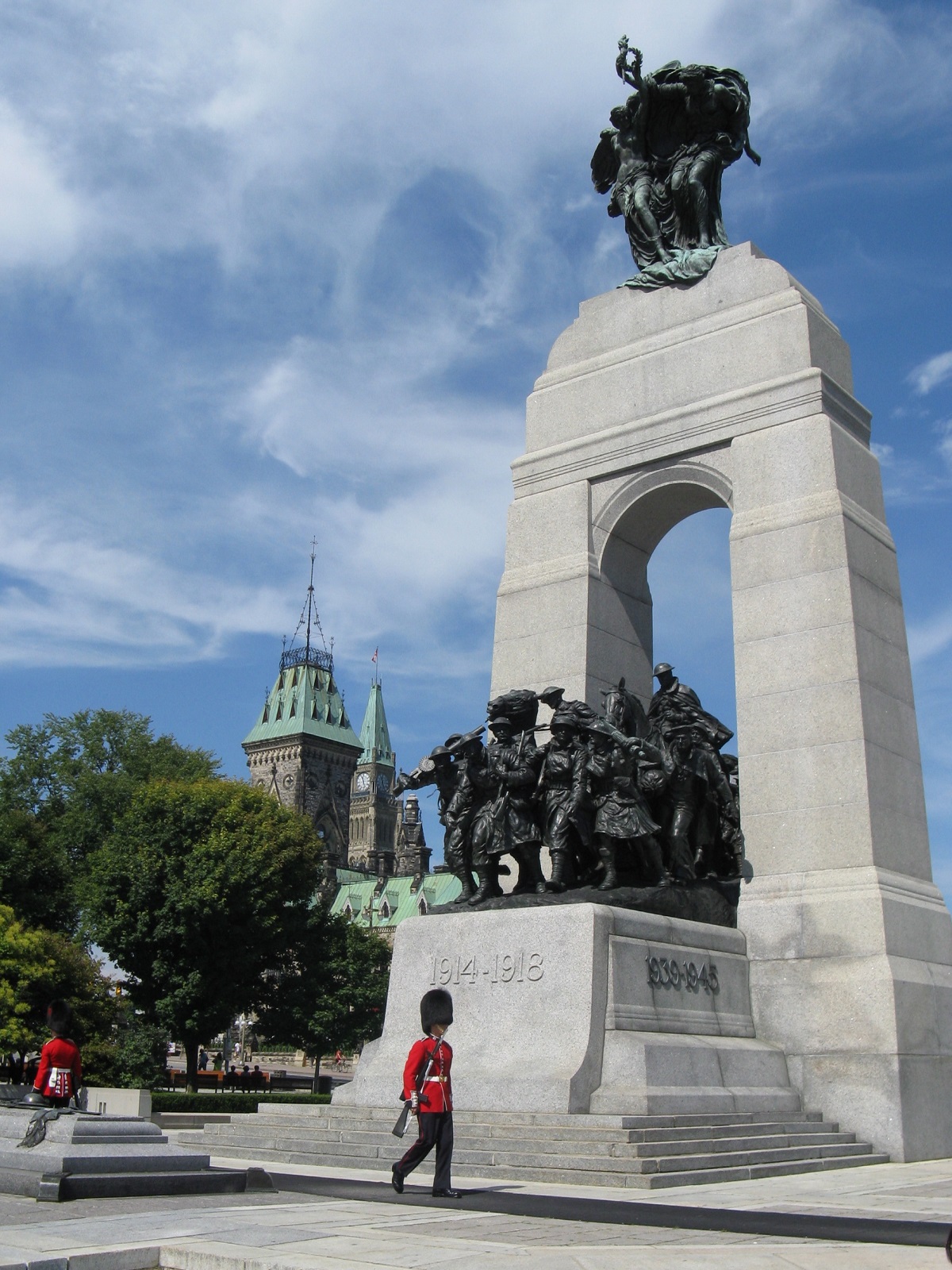
The National War Memorial is a memorial in Ottawa that was erected in 1939 to commemorate the fallen of the First World War. Since then, it has also been dedicated to the fallen in other wars in which Canadian soldiers have participated, which will not least mean the Second World War, the Korean War and the Second Boer War. In the year 2000, the Tomb of the Unknown Soldier was added to the front of the National War Memorial.
The memorial was built as a high memorial arch in granite with . It was designed by Vernon March and inaugurated by King George VI. The facility stands as the central element of Confederation Square, which is centrally located and surrounded by, among other things, Parliament Hill to the northwest, the Rideau Canal to the northeast and the National Arts Center to the east.
The National War Memorial is just over 21 meters high, and on top of the arch stand two 5 meter high allegories, symbolizing peace and freedom with a closeness that represents the inseparability of the two concepts. Below you can see the depictions of 22 Canadian soldiers from all branches of the armed forces and other groups who were involved in the First World War.
The Senate of Canada Building is the seat of the Canadian Senate, which is the upper house of the country’s parliament. The Senate building has not always housed one of Canada’s most important political institutions, having a past as the Ottawa Union Station. Thus, the site served as the city’s main railway station from 1912 to 1966.
Like many other places in North America, Toronto’s railways developed without having a unified railway yard. That role was given to the station from 1912, built by the Grand Trunk Railway, and other companies moved their traffic here until 1920, when the station became the combined Union Station.
The station was built in beaux-arts architecture with inspiration from the Baths of Caracalla in Rome for the construction of the large station hall. After the closing of the last railways from the station in 1966, the station was converted into a conference centre, and in 2013 it was decided to house the Canadian Senate here.
Notre-Dame Cathedral Basilica is a Roman Catholic basilica in the Canadian capital of Ottawa. The church is the seat of the archbishop in the city, and it was a status it was given in 1879. However, the first church on the site dates back to a small chapel from 1832. The chapel was moved across the street in 1841 to make room for a larger church. The chapel burned down in 1843, while the church was still being built.
The church was largely finished in 1846, and the following year Joseph-Bruno Guigues came here as the first bishop. In the following decades, the church complex was expanded with, among other things, the two Gothic spiers in 1866. In contrast to the exterior of the church, the church space is quite richly decorated, which Georges Buillon was responsible for. The interior is bright and attractive and is decorated with stained glass windows, statues of various religious figures and so on.
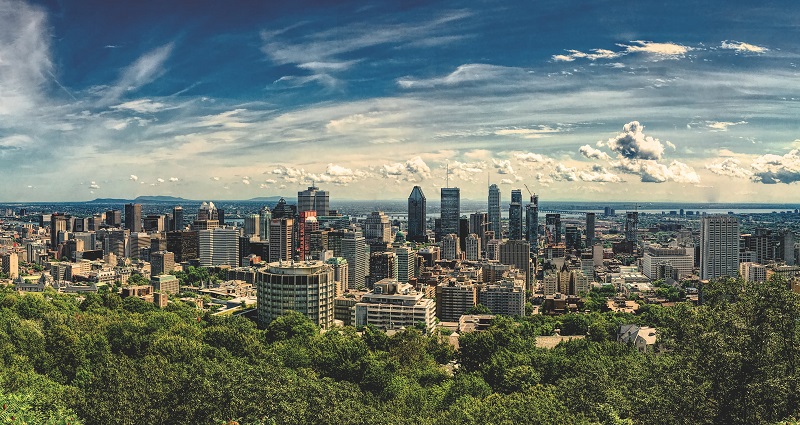
Montreal is Canada’s second largest city, and it is one of the French-speaking world’s largest cities. Montreal is also famous for design and architecture that goes far back in the city’s history. Visitors can enjoy preserved buildings dating back to the 17th century and many landmarks from the following centuries.
The Old Town offers many activities and beautiful sights. The Notre-Dame Basilica and the large Bonsecours market are two of the buildings you should definitely see, and you can also take a stroll along Rue Saint Jacques to see some 19th century headquarters for Canada’s major banks.
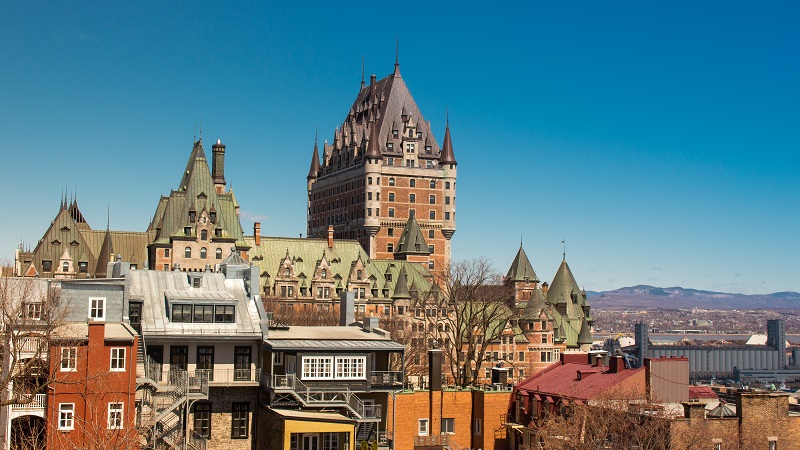
Quebec is the capital of the French-speaking Canadian province of the same name as the city. After Montreal, it is the province’s largest city and it offers numerous sights and activities for locals and visitors alike.
Founded in 1608, the city is Canada’s second oldest city. In early Québec, walls and fortifications were built around the city according to European model, and they can still be seen as the only one of its kind in the United States and Canada. The walls surround the old town, Vieux-Québec, which is included in the UNESCO World Heritage List.
100 Bayshore Drive
bayshore.shopping.ca
55 ByWard Market Square
bywardmarketsquare.com
110 Place d’Orléans Drive
placedorleans.com
50 Rideau Street
rideaucentre.net
1200 St. Laurent Blvd
stlaurent-centre.com
Bank Street Promenade, Rideau Street, Sparks Street Mall
Little Ray’s Reptile Zoo
5305 Bank Street Highway 31, Gloucester
raysreptiles.com
Musée Canadien de la Nature
Canadian Museum of Nature
240 McLeod Street
nature.ca
Musée de l’aviation du Canada
Canada Aviation Museum
11 Aviation Parkway
aviation.nmstc.ca
Musée National Sciences & Technologie
National Museum Science & Technology
1867 St Laure nt Blvd
science-tech.nmstc.ca
Papanack Park Zoo
150 County Road 19, Wend
papanack.com
Ottawa in the state of Ontario is Canada’s capital, and the city offers some great experiences of historical, contemporary and national significance to the entire country.
The first European settlement occurred in the year 1800, when Philemon Wright founded a small community. The area’s development boomed almost immediately, as the site was good for transporting timber by river to Montreal.
The government motivated immigrants to settle in the growing city, and commercially, the city continued to advance through the opening of the Rideau Canal to Lake Ontario in 1932. During the same period, the city was named Bytown, it was not until the 1850s that it was officially named the name Ottawa.
The British Queen Victoria was to designate a capital of the British Canadian province in 1857, and the election fell on that relatively small and insignificant Ottawa at the time, not least because it lay on the Quebec-Ontario border and thus on the border between the French and the English part of the province.
The government building, university and prestigious museums are some of the many buildings that have since been erected, and the city is now one of Canada’s largest urban areas with a real metropolitan atmosphere.

Overview of Ottawa
Ottawa is Canada’s capital and it is located in Ontario on the border between English-speaking and French-speaking Canada. Thus, on the opposite bank of the river is the town of Gatineau, which is part of the metropolitan area surrounding the capital.
In the cpaital there are many sights, and of course the Canadian government buildings are among the best known. The main building on Parliament Hill is the so-called Center Block, which stands in neo-Gothic architecture, that is clearly seen inside, for example, in the Confederation Hall and in the Hall of Honor.
About the upcoming Ottawa travel guide
About the travel guide
The Ottawa travel guide gives you an overview of the sights and activities of the Canadian city. Read about top sights and other sights, and get a tour guide with tour suggestions and detailed descriptions of all the city’s most important churches, monuments, mansions, museums, etc.
Ottawa is waiting for you, and at vamados.com you can also find cheap flights and great deals on hotels for your trip. You just select your travel dates and then you get flight and accommodation suggestions in and around the city.
Read more about Ottawa and Canada
Buy the travel guide
Click the “Add to Cart” button to purchase the travel guide. After that you will come to the payment, where you enter the purchase and payment information. Upon payment of the travel guide, you will immediately receive a receipt with a link to download your purchase. You can download the travel guide immediately or use the download link in the email later.
Use the travel guide
When you buy the travel guide to Ottawa you get the book online so you can have it on your phone, tablet or computer – and of course you can choose to print it. Use the maps and tour suggestions and you will have a good and content-rich journey.
Rideau Hall • Fine Museums • Parliament Buildings • Ottawa River

Overview of Ottawa
Ottawa is Canada’s capital and it is located in Ontario on the border between English-speaking and French-speaking Canada. Thus, on the opposite bank of the river is the town of Gatineau, which is part of the metropolitan area surrounding the capital.
In the cpaital there are many sights, and of course the Canadian government buildings are among the best known. The main building on Parliament Hill is the so-called Center Block, which stands in neo-Gothic architecture, that is clearly seen inside, for example, in the Confederation Hall and in the Hall of Honor.
About the upcoming Ottawa travel guide
About the travel guide
The Ottawa travel guide gives you an overview of the sights and activities of the Canadian city. Read about top sights and other sights, and get a tour guide with tour suggestions and detailed descriptions of all the city’s most important churches, monuments, mansions, museums, etc.
Ottawa is waiting for you, and at vamados.com you can also find cheap flights and great deals on hotels for your trip. You just select your travel dates and then you get flight and accommodation suggestions in and around the city.
Read more about Ottawa and Canada
Buy the travel guide
Click the “Add to Cart” button to purchase the travel guide. After that you will come to the payment, where you enter the purchase and payment information. Upon payment of the travel guide, you will immediately receive a receipt with a link to download your purchase. You can download the travel guide immediately or use the download link in the email later.
Use the travel guide
When you buy the travel guide to Ottawa you get the book online so you can have it on your phone, tablet or computer – and of course you can choose to print it. Use the maps and tour suggestions and you will have a good and content-rich journey.

The Rideau Canal is a 202 kilometer canal that connects Ottawa by water with Lake Ontario and the St Lawrence River. The canal can be seen through central Ottawa, and its lock system is the oldest in North America in continued use. The name Rideau Canal comes from the Rideau Falls, located where the Rideau River flows into the Ottawa River.
The canal opened in 1832 and its 46 locks lift ships from the Ottawa River 83 meters upstream on the Rideau River to the Rideau Lakes, and from there there is a 50 meter drop downstream on the Cataraqui River to Kingston and Lake Ontario. Over time, transport was moved to St. Lawrence Seaway, roads and railways, but the canal is used today not least by yachtsmen.
In 2007, the Rideau Canal was inscribed as a UNESCO World Heritage Site as the best-preserved example of this type of canal in North America constructed on a large scale following European models. You can get a good impression of the canal and its locks from Wellington Street.
ByWard Market is a shopping and entertainment district in Ottawa that is popular with locals and tourists. In the market area, there are both market halls and lively activity in the market streets of George Street, York Street and William Street as well as in Byward Market Square.
The story started when Lieutenant Colonel John By of the Royal Engineers was sent from England in 1826 to oversee the construction of the Rideau Canal. As part of the work, the town was planned and the first market building was erected in 1827 on George Street. Today’s market hall between George Street and York Street dates from 1926.
Ottawa City Hall is the Canadian capital’s city hall, consisting of a combination of a 19th-century wing and modern additions. The old part is particularly interesting, having been erected as the Ottawa Normal School in 1874.
The modern part of the town hall, which is the main building, was designed by the Canadian architect Raymond Moriyama and built in 1990. The town hall’s council chamber is located in this part. The current buildings are not the city’s first town halls. That was the status of the first town hall, which was used from 1849 to 1877.

The National War Memorial is a memorial in Ottawa that was erected in 1939 to commemorate the fallen of the First World War. Since then, it has also been dedicated to the fallen in other wars in which Canadian soldiers have participated, which will not least mean the Second World War, the Korean War and the Second Boer War. In the year 2000, the Tomb of the Unknown Soldier was added to the front of the National War Memorial.
The memorial was built as a high memorial arch in granite with . It was designed by Vernon March and inaugurated by King George VI. The facility stands as the central element of Confederation Square, which is centrally located and surrounded by, among other things, Parliament Hill to the northwest, the Rideau Canal to the northeast and the National Arts Center to the east.
The National War Memorial is just over 21 meters high, and on top of the arch stand two 5 meter high allegories, symbolizing peace and freedom with a closeness that represents the inseparability of the two concepts. Below you can see the depictions of 22 Canadian soldiers from all branches of the armed forces and other groups who were involved in the First World War.
The Senate of Canada Building is the seat of the Canadian Senate, which is the upper house of the country’s parliament. The Senate building has not always housed one of Canada’s most important political institutions, having a past as the Ottawa Union Station. Thus, the site served as the city’s main railway station from 1912 to 1966.
Like many other places in North America, Toronto’s railways developed without having a unified railway yard. That role was given to the station from 1912, built by the Grand Trunk Railway, and other companies moved their traffic here until 1920, when the station became the combined Union Station.
The station was built in beaux-arts architecture with inspiration from the Baths of Caracalla in Rome for the construction of the large station hall. After the closing of the last railways from the station in 1966, the station was converted into a conference centre, and in 2013 it was decided to house the Canadian Senate here.
Notre-Dame Cathedral Basilica is a Roman Catholic basilica in the Canadian capital of Ottawa. The church is the seat of the archbishop in the city, and it was a status it was given in 1879. However, the first church on the site dates back to a small chapel from 1832. The chapel was moved across the street in 1841 to make room for a larger church. The chapel burned down in 1843, while the church was still being built.
The church was largely finished in 1846, and the following year Joseph-Bruno Guigues came here as the first bishop. In the following decades, the church complex was expanded with, among other things, the two Gothic spiers in 1866. In contrast to the exterior of the church, the church space is quite richly decorated, which Georges Buillon was responsible for. The interior is bright and attractive and is decorated with stained glass windows, statues of various religious figures and so on.
Similar to Ottawa Travel Guide